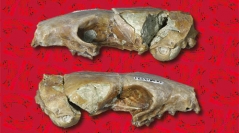

 Geodiversitas
44 (14) - Pages 427-436
Geodiversitas
44 (14) - Pages 427-436The feliform carnivoran Palaeogale von Meyer, 1846 first appears in the Eocene of North America and had a Holarctic distribution in the Oligocene and early Miocene. Despite its large range, Palaeogale has not previously been reported from the Pacific Northwest of North America. We report three new specimens from the John Day Basin of Oregon that fill in this geographic gap. The oldest of these is a largely complete cranium from the Turtle Cove Member of the John Day Formation (Oligocene, 30.0-28.9 Ma). The other two specimens are a left and a right dentary from separate individuals, both recovered from the Kimberly Member (Oligocene, 25.3-23.5 Ma). Because Palaeogale species are almost entirely distinguished by their lower dentition, the cranium cannot be identified to species. However, the cranium is the oldest occurrence of the genus in the Pacific Northwest. The absence of a posterior accessory cusp on the p4 and of lateral expansion of the m1 protoconid allows the dentaries to be assigned to an endemic North American species, P. dorothiae MacDonald, 1963. This is not only the first instance of this species in the Pacific Northwest and outside of South Dakota and Nebraska, but also the last known occurrence of P. dorothiae. We expect that these specimens will inform future analyses of phylogenetics, systematics, morphology, and biogeography in Palaeogale.
Palaeogale, Oligocene, Oregon, John Day Formation, Kimberly Member, Turtle Cove Member